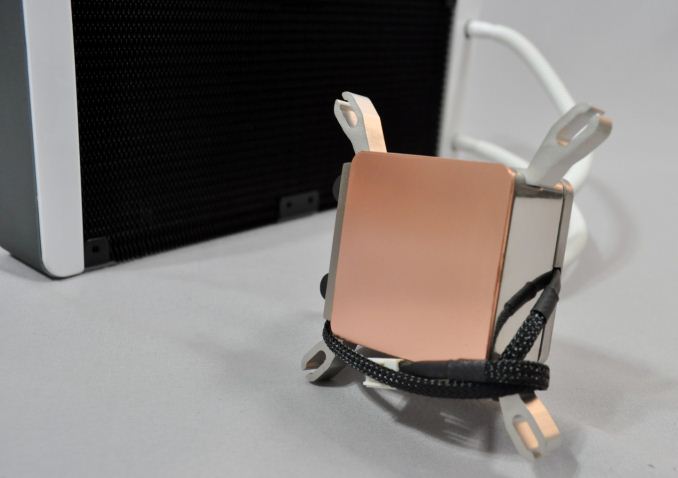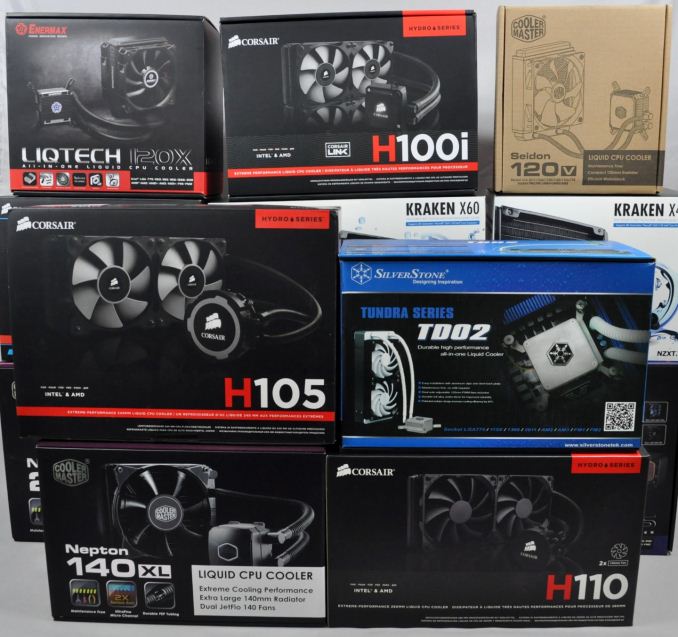Closed Loop AIO Liquid Coolers: 14-way Mega Roundup Review
by E. Fylladitakis on February 12, 2014 7:00 AM EST
Remember the time when liquid cooling a computer chip was considered to be an extreme approach, one performed by hardcore enthusiasts and overclockers alone? Everything had to be personally designed and or procured by the user, as there were no specialized commercial products available at the time. Radiators were modified heater cores extracted from cars, CPU blocks were rare and occasionally machined at local workshops using a copper block and a lathe, while high-performance tubing came from shops with medical supplies.
As demand grew, aided by the ever-increasing noise of small CPU heatsinks, companies specializing on liquid cooling solutions began turning up -- a little too fast perhaps, as tens of companies were founded within a few months' time and very few of them actually survived for more than a couple of years. Enthusiasts could then buy specialized liquid cooling equipment and even whole kits from just one seller and only had to assemble the setup into their system. That of course is no simple process for an amateur and a nightmare for a system builder, who cannot ship a system with a topped off water cooling tank or assume that the user has the skills required to maintain such a system, therefore the potential market remained limited to advanced users only.
This all changed in 2012, when Asetek came up with an inexpensive closed loop solution, a liquid cooling device that was leak-free and required no maintenance at all. The radiators of the first few solutions were small and their overall performance hardly better than that of air coolers; however, aided by the modernization of computer cases, the mounting of larger, thicker radiators inside a PC soon was not a problem. In many cases the kits were now no harder to install than any CPU cooler and required no maintenance at all, opening the market to virtually every computer user seeking a performance cooling solution. This spurred massive interest amongst OEMs and manufacturers, who all strive for a slice of the pie.
There have been tens of AIO (All-in-One) closed loop liquid coolers released just in 2013; today, we are having a roundup with 14 of them, coming from five different manufacturers, alphabetically listed in the table below.
| Product | Radiator Effective Surface | Radiator Thickness | # of Fans (Supplied / Maximum) | Speed Range of Supplied Fans (RPM) | Current Retail Pricing |
| Cooler Master Seidon 120V | 120mm × 120mm | 27mm | 1 / 2 | 600-2400 | $49.99 |
| Cooler Master Nepton 140XL | 140mm × 140mm | 38mm | 2 / 2 | 800-2000 | $99.99 |
| Cooler Master Nepton 280L | 140mm × 280mm | 30mm | 2 / 4 | 800-2000 | $119.99 |
| Corsair H75 | 120mm × 120mm | 25mm | 2 / 2 | 800-2000 | $69.99 |
| Corsair H90 | 140mm × 140mm | 27mm | 1 / 2 | 600-1500 | $84.99 |
| Corsair H100i | 120mm × 240mm | 27mm | 2 / 4 | 800-2700 | $109.99 |
| Corsair H105 | 120mm × 240mm | 38mm | 2 / 4 | 800- 2700 | $119.99 |
| Corsair H110 | 140mm × 280mm | 29mm | 2 / 4 | 600-1500 | $126.99 |
| Enermax Liqmax 120S | 120mm × 120mm | 32mm | 1 / 2 |
600-1300 600-2000 600-2500 (Multi-range) |
$163.00* |
| Enermax Liqtech 120X | 120mm × 120mm | 43mm | 2 / 2 |
600-1300 600-2000 600-2500 (Multi-range) |
$171.10* |
| NZXT Kraken X40 | 140mm × 140mm | 27mm | 1 / 2 | 800-2000 | $89.99 |
| NZXT Kraken X60 | 140mm × 280mm | 27mm | 2 / 4 | 800-2000 | $119.99 |
| Silverstone Tundra TD02 | 120mm × 240mm | 45mm | 2 / 4 | 1500-2500 | $118.99 |
| Silverstone Tundra TD03 | 120mm × 120mm | 45mm | 2 / 2 | 1500-2500 | $97.99 |
*The coolers from Enermax are not widely available in the USA at the time of this review, with the only viable option appearing to be that of import from Asia or Europe.
Although Asetek was the first to come up with the design and they hold patents for it, they are not the only OEM of AIO cooling solutions today. At least three different OEMs are behind the kits listed in the table above. We will have a closer look at each one of them in the following pages.











139 Comments
View All Comments
E.Fyll - Wednesday, February 12, 2014 - link
It would not; even pure distilled water becomes conductive once it comes in contact with dust. None of these coolers are using pure distilled water anyway, all are using a mixture, which is conductive. It has lower conductivity than mineral water, yet it is conductive. The higher the portion of the additive over the distilled water, the more conductive the solution becomes. The actual level of conductivity also depends on the additive, some are more conductive than others. However, it should suffice to say that the least conductive additive at the lowest possible concentration would still be extremely dangerous to electronics.I will summarize: If it leaks, you are doomed.
Dustin Sklavos - Wednesday, February 12, 2014 - link
"If it leaks, you are doomed" is a little alarmist. It depends on where the product leaks and how large the leak is. The cooler itself certainly isn't usable anymore if it's leaking, but we get hardware in from time to time for leak damage that actually works perfectly fine (Corsair warrants your hardware against cooler leaks).E.Fyll - Wednesday, February 12, 2014 - link
Yes, I possibly over-exaggerated there. What I wanted to stress is that the liquid is definitely conductive, not that it will cause permanent damage 100% of the time. There is a high chance that the hardware will be damaged but that is definitely not always the case. I myself had a serious (nearly 1/4 liter) leak with a custom-made setup and the system was just fine once it was dry again.jrs77 - Wednesday, February 12, 2014 - link
Enermax and Silverstone use quiet possibly Swiftech as a supplier for their AIO-blocks.And btw, you should've really integrated the Swiftech H220 into your roundup.
E.Fyll - Wednesday, February 12, 2014 - link
I know. I actually tried to acquire all AIO coolers in existence, including Intel's, Thermaltake's and others. Not everyone is happy to cooperate and/or willing/able to supply samples at a give time, for whatever reason.toyotabedzrock - Wednesday, February 12, 2014 - link
We need a roundup of fans. I have bought many expensive fans that turned out to be less than advertised and failed quickly when used in certain orientations. Even had blades break.E.Fyll - Wednesday, February 12, 2014 - link
That is going to happen, eventually. I need proper equipment to properly test fans. Until I can acquire it, I will not perform a half-assed job.HisDivineOrder - Wednesday, February 12, 2014 - link
It's reprehensible that you guys are not reviewing the Swiftech option that allows you to use the closed AIO part or switch to a more open config if you like, too.If you say, "That's because it's not on the market now!" I'll say it's because of Asetek trying to basically own the market and are using litigation to destroy competition. Was it any wonder that when the Swiftech was on the market, we had Corsair and NZXT AIO's all dropping down to sub-$100 for even their highest of the high end? The value you got for that $130-140 was so outstanding, no one would touch a single one of these coolers.
So to my eye, I don't see why you'd bother reviewing such subpar products that are at ludicrous pricing and reward Asetek and their twin from another mother for not bothering to compete.
Not going to reward patent trolls.
E.Fyll - Wednesday, February 12, 2014 - link
Copy-paste from above:"I know. I actually tried to acquire all AIO coolers in existence, including Intel's, Thermaltake's and others. Not everyone is happy to cooperate and/or willing/able to supply samples at a give time, for whatever reason."
I cannot test what I cannot have access to. I would love to test Swiftech's products but the company needs to be willing to ship me samples first.
Dustin Sklavos - Wednesday, February 12, 2014 - link
"Reprehensible" is an awfully strong word, isn't it? There's a lot of logistics that go into just trying to put together a roundup like this, and respectfully, you don't have the full picture of Asetek's patent or what's going on in the AIO market.